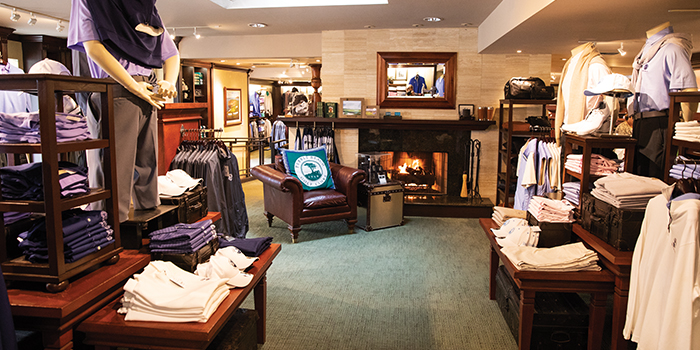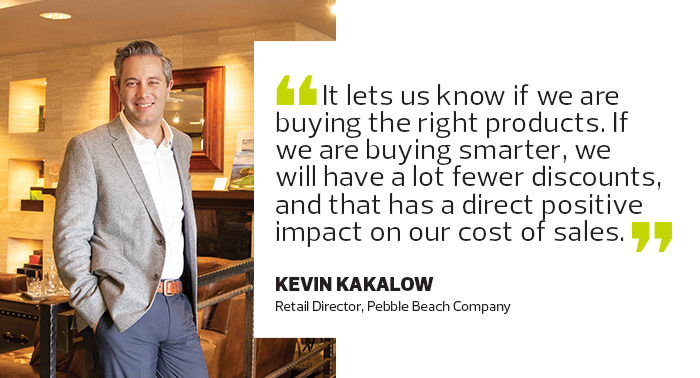How Technology Is Delivering the Future of Retail Today
Vacationers and tourists visit Pebble Beach Resorts year-round for its famous golf courses, luxurious spa, fine dining and other sports activities — all with breathtaking ocean views of California’s Central Coast as a backdrop. Visitors also browse through Pebble Beach’s 16 boutiques to shop for gifts and souvenirs, from golf and lifestyle apparel to home spa products and wineglasses, many featuring the Pebble Beach logo.
To maximize sales, Pebble Beach’s retail operations recently implemented IBM Planning Analytics software to gather sales information that’s updated daily, so they can better evaluate inventory needs and replenish the most popular items before they are sold out.
“If we do our jobs right, and this new system helps us get there, then the customer walks away with a great experience at our retail stores,” says Kevin Kakalow, director of retail at Pebble Beach Company, which owns Pebble Beach Resorts. “They are not frustrated because we were out of stock or could not find what they were looking for.”
SIGN UP: Get more news from the BizTech newsletter in your inbox every two weeks!
These are challenging times for brick-and-mortar retailers, who are feeling the sting of online competitors more than ever. In the first months of 2018 alone, longtime retailer Toys R Us announced it was closing its doors, while mall-based chains Nine West and Claire’s both filed for bankruptcy.
In response, forward-looking retailers are deploying technology to create new in-store experiences, bolster customer loyalty and retention, and ultimately boost sales. Some gather customer data to drive better business decisions, while others take advantage of augmented or virtual reality and mobile apps to merge the online and in-store shopping experience.
“We will always have brick-and-mortar stores, just not as many,” says retail expert Jan Rogers Kniffen. “The fewer ones will have to be more accurate, entertaining and exciting, and provide much better customer service if they are to be successful.”

Pebble Beach Company deploys advanced analytics to manage inventory at its pro shop and other retail outlets.
Retailers Tap Data for Insights
Apparel and accessory retailers had their best year managing inventory control in 2017, and that’s due to Big Data, Kniffen says. By deploying data analytics, they were able to stock shelves more accurately, which led to fewer markdowns and improved profits, he says.
Pebble Beach Company, with its three hotels and four golf courses, offers a perfect example. Its retail department implemented cloud-based IBM Planning Analytics in late 2016 to gain faster insights into the company’s vibrant 16-store retail operation.
Anchored by the scenic 17-Mile Drive, the resort also attracts tourists passing through on day trips and bus tours. For them, the most popular store is the Lone Cypress Shop, featuring clothes, golf accessories and knickknacks that carry the Pebble Beach logo.
Kakalow says IBM Planning Analytics automated what used to be largely a manual process.

A detailed inventory report or sales forecast that might take three hours to produce can now be had in minutes.
In the past, Kakalow and his finance manager manually exported data from an inventory management system, a point-of-sale system and general ledger software onto an Excel spreadsheet. Each time, they’d have to massage the data. “It was a weird data dump with dashes, spaces and different columns not lined up, so we had to clean it up and get it to the point where we could actually use it,” he says.
Pebble Beach’s IT and retail departments worked with a third-party consultant to implement IBM Planning Analytics over a nine-month period. Working together, the companies integrated the inventory management, point-of-sale and general ledger systems. Sales data is now uploaded automatically to the IBM software each day. “Now that the data is housed in one platform, we can build models and slice and dice the data much more quickly,” Kakalow says.
The retail department can review inventory on the sales floor, spot trends in customer preferences, improve their merchandizing decisions and choose the most effective pricing for each product.
That’s where technology supports old-fashioned customer service, Kakalow says. When employees check out customers, they strike up conversations, asking if the customer is a resort guest, bus tour guest or day visitor. The sales staff can then classify the buyer with the press of a button on the point-of-sale system. The retail division can then analyze the information about what each type of guest buys, helping the company make smarter decisions on what to stock in individual stores — and for the first time, the company can also compare historical inventory data by day.
“It lets us know if we are buying the right products,” Kakalow says. “If we are buying smarter, we will have a lot fewer discounts, and that has a direct positive impact on our cost of sales.”
Analytics Illuminate Customer Behavior
Retailers capture all kinds of data to better understand their customers’ preferences, so they can create better customer experiences.
Santana Row, an upscale mixed-use shopping center with retail stores, restaurants, office space, condos and apartments in San Jose, Calif., installed Cisco networking gear to provide fast, free amenity-based Wi-Fi to customers and residents. Combined with Cisco’s Connected Mobile Exchange (CMX) Cloud software, the wireless network also allows property owner Federal Realty Investment Trust to gain what it calls “path intelligence,” or the ability to see and analyze visitors’ foot traffic patterns.
This geolocation data allows the company to discover customers’ behavioral patterns, which helps with merchandising, property management and targeted marketing campaigns, says Abbas Rizvi, Federal Realty’s senior network manager.
“We can build an understanding of what the traffic patterns are on the property, get information on dwell times, where visitors go when they are here, what path they take, and how many times they come back,” he explains. Retail leasing staff, for example, can use foot traffic information to negotiate better lease terms for retail spaces or property management can determine the appropriate security levels for planned events. The marketing department can use the data to develop marketing plans for specific customer demographics or work with retailers on cross-promotions and gauge the success of events, Rizvi says. Federal Realty deployed 35 Cisco Aironet 802.11ac outdoor access points on rooftops. About two years ago, Rizvi implemented Cisco’s CMX Cloud to register and connect customers to the wireless network to build data on path analysis and customer demographics.

Customers sign in to Santana Row’s Wi-Fi using their email address or by logging in through Facebook. Individual information stays anonymous. The information is aggregated monthly, allowing the company to analyze the data, he adds.
Federal Realty engages the customers with specialized email campaigns about upcoming events and promotions.
“It’s about finding the right balance on how we use technology to engage customers while providing a great visitor experience,” Rizvi says.
Stores Experiment With Emerging Tech
Retailers are also experimenting with new technologies to marry the online and in-store shopping experiences. Home improvement chain Lowe’s, for example, has developed two mobile apps that take advantage of augmented reality. The company’s “View In Your Space” AR feature on its mobile app allows Android smartphone users to preview what patio furniture, grills, smokers and appliances would look like in their own home spaces. Lowe’s has also developed an in-store navigation app that allows customers to find products faster by giving them step-by-step directions to the products, says Josh Shabtai, director of labs productions and operations for Lowe’s Innovation Labs.
Shabtai and his team have also created in-store virtual reality experiences at select stores. One immersive VR experience gives customers interactive instructions on do-it-yourself projects, such as how to tile a bathroom. Customers who receive the instruction using a VR headset remember 40 percent more of the project’s steps than those who watch an instructional video, Shabtai says. Another experience allows customers to try a cordless hedge trimmer in a virtual environment. A team of video game developers, technical artists and experts in computer vision create the AR and VR experiences, Shabtai says.
“Customer response has been extremely positive,” he says. “Virtual and augmented reality are giving us powerful new ways to help our customers gain the vision, confidence and skills to begin their next project.”









